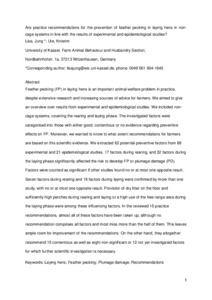Aufsatz

Are practice recommendations for the prevention of feather pecking in laying hens in non-cage systems in line with the results of experimental and epidemiological studies?
Zusammenfassung
Feather pecking (FP) in laying hens is an important animal welfare problem in practice, despite extensive research and increasing sources of advice for farmers. We aimed to give an overview over results from experimental and epidemiological studies. We included non-cage systems, covering the rearing and laying phase. The investigated factors were categorised into those with either good, contentious or no evidence regarding preventive effects on FP. Moreover, we wanted to know to what extent recommendations for farmers are based on this scientific evidence. We extracted 62 potential preventive factors from 88 experimental and 21 epidemiological studies. 17 factors during rearing, and 32 factors during the laying phase significantly affected the risk to develop FP or plumage damage (PD). Factors were counted as significant if other studies found no or at most one opposite result. Seven factors during rearing and 16 factors during laying were confirmed by more than one study, with no or at most one opposite result. Provision of dry litter on the floor and sufficiently high perches during rearing and laying or a high use of the free range area during the laying phase were among these influencing factors. In the reviewed 15 practice recommendations, almost all of these factors have been taken up, although no recommendation comprises all factors and most miss more than the half of them. This leaves ample room for improvement of the recommendations. On the other hand, they altogether recommend 15 contentious as well as eight non-significant or 12 not yet investigated factors for which further scientific investigation is necessary.
Zitierform
Jung, L., Applied Animal Behaviour Science (2017), http://dx.doi.org/10.1016/j.applanim.2017.10.005Förderhinweis
Lower Saxony Ministry for Science and CultureZitieren
@article{urn:nbn:de:hebis:34-2018012254208,
author={Jung, Lisa and Knierim, Ute},
title={Are practice recommendations for the prevention of feather pecking in laying hens in non-cage systems in line with the results of experimental and epidemiological studies?},
year={2017}
}
0500 Oax 0501 Text $btxt$2rdacontent 0502 Computermedien $bc$2rdacarrier 1100 2017$n2017 1500 1/eng 2050 ##0##urn:nbn:de:hebis:34-2018012254208 3000 Jung, Lisa 3010 Knierim, Ute 4000 Are practice recommendations for the prevention of feather pecking in laying hens in non-cage systems in line with the results of experimental and epidemiological studies? / Jung, Lisa 4030 4060 Online-Ressource 4085 ##0##=u http://nbn-resolving.de/urn:nbn:de:hebis:34-2018012254208=x R 4204 \$dAufsatz 4170 7136 ##0##urn:nbn:de:hebis:34-2018012254208
<resource xsi:schemaLocation="http://datacite.org/schema/kernel-2.2 http://schema.datacite.org/meta/kernel-2.2/metadata.xsd"> 2018-01-22T12:37:25Z 2018-01-22T12:37:25Z 2017-10-14 urn:nbn:de:hebis:34-2018012254208 http://hdl.handle.net/123456789/2018012254208 Lower Saxony Ministry for Science and Culture eng Elsevier B.V. Urheberrechtlich geschützt https://rightsstatements.org/page/InC/1.0/ Laying hens Feather pecking Plumage damage Recommendations 630 Are practice recommendations for the prevention of feather pecking in laying hens in non-cage systems in line with the results of experimental and epidemiological studies? Aufsatz Feather pecking (FP) in laying hens is an important animal welfare problem in practice, despite extensive research and increasing sources of advice for farmers. We aimed to give an overview over results from experimental and epidemiological studies. We included non-cage systems, covering the rearing and laying phase. The investigated factors were categorised into those with either good, contentious or no evidence regarding preventive effects on FP. Moreover, we wanted to know to what extent recommendations for farmers are based on this scientific evidence. We extracted 62 potential preventive factors from 88 experimental and 21 epidemiological studies. 17 factors during rearing, and 32 factors during the laying phase significantly affected the risk to develop FP or plumage damage (PD). Factors were counted as significant if other studies found no or at most one opposite result. Seven factors during rearing and 16 factors during laying were confirmed by more than one study, with no or at most one opposite result. Provision of dry litter on the floor and sufficiently high perches during rearing and laying or a high use of the free range area during the laying phase were among these influencing factors. In the reviewed 15 practice recommendations, almost all of these factors have been taken up, although no recommendation comprises all factors and most miss more than the half of them. This leaves ample room for improvement of the recommendations. On the other hand, they altogether recommend 15 contentious as well as eight non-significant or 12 not yet investigated factors for which further scientific investigation is necessary. open access Jung, L., Applied Animal Behaviour Science (2017), http://dx.doi.org/10.1016/j.applanim.2017.10.005 Jung, Lisa Knierim, Ute SPERRFRIST bis 01.11.2018 Artikelversion: Akzeptiertes Manuskript doi:10.1016/j.applanim.2017.10.005 </resource>
Die folgenden Lizenzbestimmungen sind mit dieser Ressource verbunden:
Urheberrechtlich geschützt

